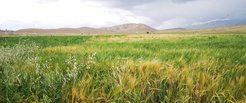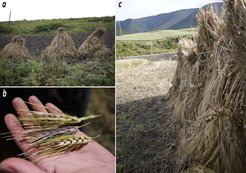Exploring Grain Size Variation in Prehistoric Central Asian Barley

Barley field in the Kochkor valley, Kyrgyzstan
Over the past ten millennia, barley has followed humanity across the ancient world and evolved to more extreme ecologies than any other crop. From the fjords of far northern Europe to the rooftop of the world in Tibet, barley has remained the crop of choice for people adapting to extreme ecosystems. While the study of plant remains at archaeological sites, known as archaeobotany, has revealed much about the routes and timing of barley’s spread, how early farmers made use of the crop and the processes that drove it’s adaptation are still largely a mystery. In a recent collaborative study lead by researchers at Vilnius University and the Max Planck Institute for the Science of Human History, scientists compare changes in the size and shape of ancient barley grains from Europe and Central Asia to understand and highlight the plausible drivers for population-scale change through time. Their results show that grains were gradually evolving to become larger in Central Asia in parallel with similar size increases in Europe. In addition, they found that the early barley grains from Central Asia expressed unique compact morphotypes in response to new environments that they first colonized.

The recognition that extreme variation exists among landraces of crops, especially in pre-modern varieties, dates back at least to Charles Darwin’s famous 1868 book, The Variation of Animals and Plants Under Domestication. Darwin recognized that this variation could either be a response to ecological conditions or programed in the plant. Thus far, however, investigations into the evolution and development of barley grains have been restricted to European or southwest Asian datasets.
In the current study, morphological data - or information about the form and structure of an organism - of grains recently recovered from archaeological sites in Central Asia provide the team with a contrastable dataset, allowing them to track changes over time and contrast those changes with the ones observed in Europe.
“When we examine seed size changes in crops, we should remember that people are not always responsible for everything that happens during plant development. Plants, barley in particular, are great at coping with ecological stressors, and those coping mechanisms show up as variation in the archaeobotanical record,” shares Ms. Mir-Makhamad, a PhD student in the Archaeobotany Laboratories.
Excavations at the Chap site in the central Tian Shan Mountains of Kyrgyzstan, directed by Giedre Motuzaite Matuzeviciute, the head of the Bioarcheology Centre of Vilnius University and Kubatbek Tabaldiev from the Kyrgyz-Turkish Manas University in Bishkek, have provided some of the richest assemblages of ancient wheat and barley grains thus far recovered from prehistoric Central Asia. Occupation at the site stretches back more than 4,500 years and involved the adaptation of farming and herding systems to a high-elevation ecosystem. These data allow for population-scale glimpses into size change and variation over time.
Dr. Motuzaite Matuzeviciute summarized the significance of this study stating, “The data recovered from a crop grown on the margins of its ecological range can be highly informative as to what biological and environmental factors were driving variation.”
The team argues that variation could be the result of the evolution of ecotypes, adaptation to local environmental stress, improvement in agricultural technologies, or a consequence of uniform stress from growing crops on the margins of their growing ranges. They are quick to point out, however, that there are many possible factors driving either evolutionary or developmental changes in crop plants. While they do not parse out all the driving mechanisms in this study, they hope their new data will spark more research and discussion in the future.
“The possibility of parallel grain size evolution among different lineages of barley independently is exciting, but we caution that this is just the first step in a much larger study,” says Dr. Robert Spengler, director of Archaeobotany Laboratories at Max Plant Institute and a senior author of this paper.
In addition to proposing possible reasons for diachronic seed size changes, this study encourages further research applying multi-proxy data and pushes for a greater focus on the prehistory of Central Asia.

